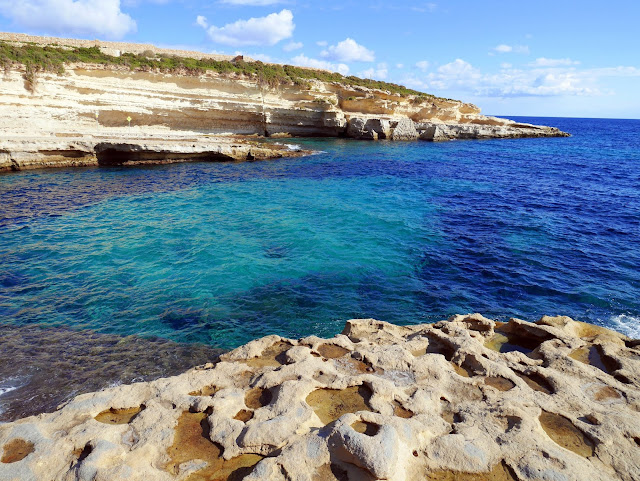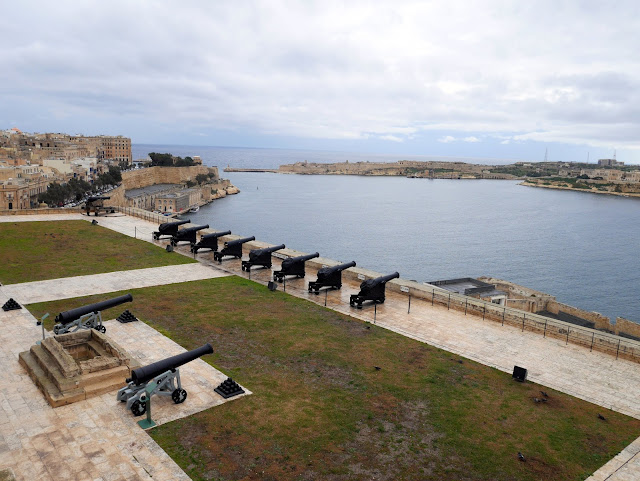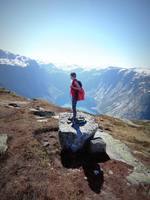Malta: complete practical info
European seaside destinations are always a bit of a lottery in the off-season, weather-wise. But no one can guarantee sunny days during your visit, even in July, right? Personally, I'm always prepared for the worst case scenario => it's going to piss and piss and piss and the alternative plan becomes sitting around cafes dashing to the bar in the hotel lobby. Fortunately, that didn't happen in the case of the Malta trip... maybe only partially :)
Anyway, when a bad weather situation happens in January, when you pay €28 for a return ticket (Ryanair from Nuremberg), it definitely doesn't hurt as much as in the high season, when the ticket costs half of your salary and you are squeezed in a crowd of equally overwhelmed tourists at the aforementioned bar.
Transport on the island

Malta has a surprisingly dense network of bus lines that can take you almost everywhere, apart from the various sightseeing spots etc. Assuming you have the time, of course, as their reliability is debatable. I don't have personal experience, but according to various blogs and discussions it's not uncommon for a bus to arrive half an hour late or not at all, or not stop because it's already full... I'm just glad I don't have that experience :) Plus, it leaves you to constantly follow the timetables, which removes the flexibility and the possibility to change plans from minute to minute, maybe because of the weather... or your mood.
You can find all the information about bus transport on this official website. They are really very clear and you can navigate very quickly. There are complete timetables, in which you can also search for individual routes. The most important thing for you is probably the price: in high season (mid-June to mid-October) the fare is €2, other months it is only €1.50. The ticket is valid for 2 hours, is a transfer ticket and you buy it from the driver when you board the bus (cash only). If you're planning on driving across the island, be sure to get a 7 day pass for €21 (also valid for Gozo). In this case, you will use the hop on hop off buses whenever you want. You can buy this magic card right at the airport, or you can find a full list of outlets here.
Car rental and driving in Malta
Yeah, that was a very funny thing to say. After buying the flights, I started researching all the necessary details about Malta. A European country... the Mediterranean... renting a car an obvious choice, what could possibly go wrong? Everything! Because in Malta, they drive FORWARD! Ouch, my brilliant itinerary suddenly suffered a major crack. We've only ridden a scooter once on the left in Thailand and there was basically zero to nothing traffic, so the fears of taking this step into the unknown were really big. It's just that our team roles are split pretty clearly - me = flights, accommodation, programme, Pepa = car, driving, petrol, parking. So the decision went something like this:
- sad eyes on the potential driver
- the argument that we definitely can't do without a car
- buying full insurance
- the promise of 150% attention while driving - more eyes see more
- reminding the left side when entering a roundabout or exiting a car park
- constant psychological support
- snail's pace
 Fortunately, it wasn't as tragic as we originally thought. There was hardly any traffic in the off-season, we didn't stand in traffic jams or traffic jams anywhere, and the fact that someone honked at us now and then was completely eliminated. Compared to Italy, for example, it's much more relaxing to drive here. The best was when a car was in front of us and all we had to do was hold on to it. Worse were the exits from the car park, when you have to concentrate a lot to turn left and not according to the iron habit. And the worst was left-hand shifting and getting into the car - meaning those situations when we each rushed to "our" side. We didn't even practice that in those 3 days :)
Fortunately, it wasn't as tragic as we originally thought. There was hardly any traffic in the off-season, we didn't stand in traffic jams or traffic jams anywhere, and the fact that someone honked at us now and then was completely eliminated. Compared to Italy, for example, it's much more relaxing to drive here. The best was when a car was in front of us and all we had to do was hold on to it. Worse were the exits from the car park, when you have to concentrate a lot to turn left and not according to the iron habit. And the worst was left-hand shifting and getting into the car - meaning those situations when we each rushed to "our" side. We didn't even practice that in those 3 days :)The rental itself we took through booking.com, specifically the AVIS/Budget rental company, with which we had previous good experiences. The price of car rental in Malta is very cheap, we paid extra for full insurance at the counter for peace of mind, but even so it was nothing drastic. We didn't even go through 3/4 of a tank of gas in 3 days of driving around the island with the Hyundai i10, and all in all, this is how it worked out financially:
- rent a car - €25
- full insurance - €61
- petrol - €19
- parking - we didn't pay anywhere, you could find unpaid
What else to be prepared for, besides driving on the left?
Leaving aside the left-hand drive, there are two other things you'd expect to find in England rather than southern Europe. The first one I would mention is ENGLISH. I was actually quite surprised by this, because in the southern states it is certainly not a given that everyone understands English. But in Malta, English is an official language along with Maltese. Wherever you go and don't start a conversation in Maltese, they automatically start at you in English.

The second thing - ADAPTER. Write it on the itinerary in big letters, put a reminder on your cell phone, on the bulletin board, on the fridge, I don't know where else, but just don't forget it. Outlets are completely different in Malta, so if you don't have an adapter, you definitely won't charge your phone here. In the Czech Republic we are used to 2 round holes, whereas in Malta they have 3 rectangular ones + you can often find an ON/OFF button by the sockets. So this was another occasion where we could use our sjupr multi adapter, which we bought for I don't know exactly what holiday. It costs a few crowns and contains a total of 5 attachments for different parts of the world, it looks something like this.
And finally the good news, without the English influence - we pay with EURO here. This is because Malta is the smallest member state of the European Union, so you don't have to frantically fly to an exchange office to get pounds, or search the island for ATMs. Plus, everywhere we went you could pay by card.
I would like to mention a special kind of cola - Kinnie, which is produced in Malta. This coke has a slightly bitter orange flavour and I personally liked it better than regular Coca Cola or Pepsi (which I don't normally drink at all), probably because it is not so sweet. As far as gastro experiences per se are concerned, Maltese cuisine is typically Mediterranean and there is a definite influence of nearby Italy. You can taste fish, seafood, pizza and local specialities such as rabbit, traditional bigilla pate, ravioli stuffed with ricotta, pastizzi = puff pastry bags again with ricotta, or lampuki = a type of fish that migrates around the island during autumn. Maltese wines are also renowned - traditional varieties include Gellewza and Girgentina. Beer drinkers are then tasked with trying the Cisk brand, which I won't say anything about because I don't really like beer... yeah, I'm from Pilsen... yeah, I don't drink beer :D
 |
 |
Where to stay
 Malta is very small island, so it's actually close to everywhere. If you stay somewhere about in the middle, you'll be within a 25 minute drive of every coastline. Anyone interested in a convenient central location and also one of the best accommodations we've ever been to, definitely check out BB de Rohan. Amazing boutique hotel with beautiful stylish rooms, swimming pool, pool table, wine bar and luxury breakfast. We paid €56 per night including breakfast and I was only sorry that I didn't book all 3 nights here.
Malta is very small island, so it's actually close to everywhere. If you stay somewhere about in the middle, you'll be within a 25 minute drive of every coastline. Anyone interested in a convenient central location and also one of the best accommodations we've ever been to, definitely check out BB de Rohan. Amazing boutique hotel with beautiful stylish rooms, swimming pool, pool table, wine bar and luxury breakfast. We paid €56 per night including breakfast and I was only sorry that I didn't book all 3 nights here. We had a late night arrival from Nuremberg and there was no point in moving, so I booked an apartment that was a 10 minute walk from the airport. There was only a shared bathroom and a shared kitchen, but we didn't meet anyone, so we survived in good health. The place is called Large Apartment and for night arrivals or early morning departures it's absolutely perfect, priced at €40/night for a large room (smaller was cheaper).
We spent our last night in the northern part of the island in the town of Mellieha. Thanks to an off-season offer, I managed to find a hotel with a swimming pool (including a rooftop one), sauna and breakfast for €44 for a room corresponding to a classic four-star. Well, don't take it, right? :) The name of this hotel is Solana Hotel & Spa: It also has its own restaurant, café and wellness area where you can book massages or other treatments.
If you want to stay as close to the sea as possible, check here:
- cheaper: AX Seashells Resort - St. Paul´s Bay
- more expensive: Radisson Blu Resort & Spa - right on the most famous beach Golden Beach, or Marina Hotel Corinthia near St. George's Bay
Capital city - Valletta
 Accessibility: Valletta is a few kilometres from Luqa Airport and if you don't have a car, you can easily get here by bus line X4. As far as a car is concerned, parking is a bit of a problem here, but (at least in low season) it's not exactly impossible. You're not allowed to drive into the historic centre because of the zones, so watch out for that, but there is a public car park between the Ministry of Education and the Grand Hotel Excelsior where you could find a free space and we didn't even pay anything there.
Accessibility: Valletta is a few kilometres from Luqa Airport and if you don't have a car, you can easily get here by bus line X4. As far as a car is concerned, parking is a bit of a problem here, but (at least in low season) it's not exactly impossible. You're not allowed to drive into the historic centre because of the zones, so watch out for that, but there is a public car park between the Ministry of Education and the Grand Hotel Excelsior where you could find a free space and we didn't even pay anything there.Valletta is on the Sciberras Peninsula, where it is washed by two bays: the Grand Harbour and Marsamxett Harbour. Looking at its enormous walls, you won't be surprised to learn that it was designed as a fortress from the beginning. Some of the places here even served as film locations for the famous Game of Thrones series. From the huge walls, you can see the surrounding area of Valletta, which is very rugged - you will see other towns, ports, districts, promontories and islands. But the city centre itself is also very special, with its parallel streets forming an almost perfect chessboard. The main avenue is Republic Street, from which individual streets slope down towards the ocean. A beautiful and very photogenic sight!
 |
 |
But these alleys are photogenic for something else. Valletta is typical for its bay-windowed houses, which play with all colours and thus represent a very rewarding subject for photographers... even photography junkies like me :) Among other things, Valletta as a whole is a UNESCO World Heritage Site. Whether because of the fortifications or the cute little streets, I really have no idea... And what else is there to see and photograph?
- Triton Fountain - located just outside the walls of Valletta, a few metres from the bus station. So it will probably be the first thing you see.
 |  |
 |
| walls a few meters from the fountain |
- Upper Barakka Gardens - gardens located on top of the city walls, offering a great view of the harbour and other towns and forts on the bay. And because they're really quite high up, you can even take the elevator from Grand Harbour (down for free, up for €1). For those who are interested, the Lower Barakka Gardens are a little further on.
 |
 |
+ view of the Grand Harbour from the walls
 |
 |
- Fort St. Elmo - a fort at the very end of the Sciberras Peninsula to protect the entrance to Grand Harbour Bay. It is now home to the National War Museum and you can visit it too. For more information on opening times and admission fees, visit this official website.
- Siege Bell War Memorial - A war memorial serving as a remembrance of the people who died because of the horrors of World War II. It's shaped like a chapel and has a giant bell inside, plus a great view of the harbour and Breakwater Bridge, at the end of which stands St. Elmo's Lighthouse.
 |
 |
- bay windows - the best way to get to know Valletta is to get lost in the alleys and just enjoy this colonial look
 |
 |
+ view of Marsamxett Harbour: Manoel Island fortress (open to the public) + Sliema town on the other side of the bay
 |
 |
Of course, there are plenty of museums and cathedrals, but I won't explore Valletta any more. There are plenty of tips everywhere, check out Tripadvisor for example, either way it's up to your taste and time. It's not a very big city, so one day spent here is quite enough for me. If you'd like to stay in Valletta, check out these accommodations, but expect prices to be higher here than anywhere else in Malta:
- cheaper: Casa Asti - room for two in a guesthouse with shared bathroom and breakfast for about €72
- more expensive: The Barrister - luxury design, prices according to room type
I have saved the other beautiful places on this island for another article, which you can check out here - The best of Malta. Hope you enjoy it :)
If this information has helped you to save some time or money or both, you can "invite me for a coffee" and contribute to the running of Travel with Donuts :) account number / QR code: 1257951017/3030


































Žádné komentáře: